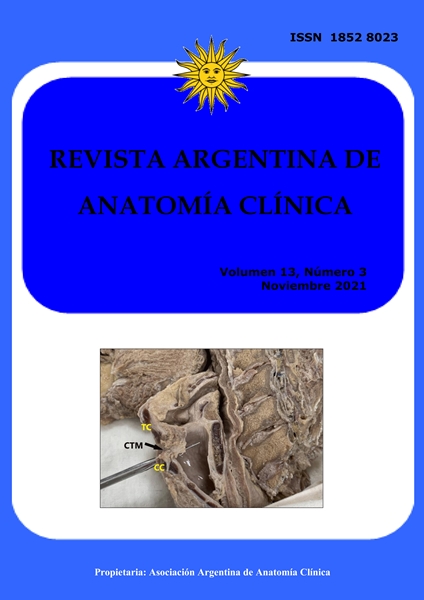BILATERAL VARIABILITY OF Q ANGLE IN SYMPTOMATIC UNILATERAL AND SYMPTOMATIC BILATERAL KNEE PAIN IN INDIAN ADULTS OF DECCAN PLATEAU REGION
DOI:
https://doi.org/10.31051/1852.8023.v13.n3.34592Keywords:
Quadriceps angle, Symptomatic unilateral knee pain and symptomatic bilateral knee pain, bilateral variability.Abstract
Objectives: Quadriceps angle (Q angle) is a lonesome clinical measure, appraised as a critical factor for the posture maintenance and knee related complications.The excessive Q angle increases the lateral patellofemoral junction pressure, which have a tendency to add biomechanical stress over the knee, leads to patellofemoral complications. This study was attempted to determine the right and left Q angle variabilitybetween asymptomatic or control (ASY), symptomatic unilateral knee pain (SUKP), and symptomatic bilateral knee pain (SBKP) in people of Deccan plateau in India. Material and methods:The bilateral Q angles were measured by universal goniometer in 235subjectsof both genders including asymptomatic (n=135), symptomatic unilateral knee pain (n=60) and symptomatic bilateral knee pain (n=40), in upright standing position, with relaxed quadriceps and fully extended knee.Subjects with clinically determined anterior knee pain considered as symptomatic. Results: The higher bilateral variability of Q angle was noticed in females than males between asymptomatic and SUKP (-5.920) and SBKP (-4.090) on right side and between asymptomatic and SUKP (-4.980) on left side. There was bilateral significant difference in Mean Q angle between asymptomatic and SUKP, and between asymptomatic and SBKP in both sexes. However, the above difference was statistically not significant between SBKP and SUKP. Conclusion: Moderate Q angle bilateral variability was noticed in symptomatic subjects due to malalignment of limbs by trauma, unilateral stance of limb and other influencing factors.
Downloads
References
Sra A, Ba T, Oo J. 2007. Comparison of bilateral quadriceps angle in asymptomatic and sympto-matic males with unilateral anterior knee pain. The Internet Journal of Pain, Symptom Control and Palliative Care 6: 1-6.
Choudhary R, Malik M, Aslam A, Khurana D, Chauhan S. 2019. Effect of various parameters on Quadriceps angle in adult Indian population. Journal of Clinical Orthopaedics and Trauma 10: 149-54.
France L, Nester C. 2001.Effect of errors in the identification of anatomical landmarks on the accuracy of Q angle values. Clin Biomech (Bristol, Avon) 16: 710-13.
Freedman BR, Bridle TJ, Sheehan FT. 2014. Re-evaluating the functional implications of the Q-angle and its relationship to in-vivo patella-femoral kinematics. Clin Biomech (Bristol, Avon) 29: 1139-45.
Greene CC, Edwards TB, Wade MR, Carson EW. 2001. Reliability of the quadriceps angle measurement. American Journal of Knee Surgery 14: 97-103.
Hahn T, Foldspang A. 1997. The Q angle and sport. Stand J Med Sci Sports 7: 43-48.
Heiderscheit BC, Hamill J, Caldwell GE. 2000. Influence of Q-angle on lower-extremity running kinematics. J Orthop Sports Phys Ther 30: 271-78.
Horton MG, Hall TL. 1989. Quadriceps femoris muscle angle: normal values measures and relationships with gender and selected skeletal. Phys Ther 69: 897-901.
Hungerford DS, Barry M. 1979. Biomechanics of the patellofemoral joint. Clin Orthop Relat Res 144: 9–15.
Jaiyesimi AO, Jegede OO. 2009. Influence of Gender and Leg Dominance on Q-angle Among Young Adult Nigerians. AJPARS 1: 18-23.
Jha A, Raza H. 2000. Variation in q-angle according to sex, height, weight and inter-spinous distance - a survey. Indian Journal of Orthopaedics 34: 99.
Khasawneh RR, Allouh MZ, Abu-El-Rub E. 2019. Measurement of the quadriceps (Q) angle with respect to various body parameters in young Arab population. PLoS One 14: 1-13.
Livingston LA, Mandigo JL. 1999. Bilateral Q angle asymmetry and anterior knee pain syndrome. Clinical Biomechanics 14: 7-13.
Livingston LA, Mandingo JL. 1997. Bilateral within-subject Q-angle asymmetry in young adult females and males. Biomedical Sciences and Instrumentation 9: 112-17.
Melo de Paula GM, Molinero de Paula VR, Almeida GJM, Machado VEI, Baraúna MA, Bevilaqua-Grosso D. 2004. Correlação entre a dor anterior dojoelho e a medida do ângulo Q porintermédio da fotogrametria computadori-zada. Rev Bras Fisioter 8: 39-43.
Olagbegi OM, Ayeni OG, Jegede JA, Kayode-Imoru OO, Areoye JO. 2014. Age grade distribution of high quadriceps angle in a selected Nigerian population. Medicina Sportiva X: 2457-61.
Powers CM. 2003. The Influence of Altered Lower-Extremity Kinematics on Patellofemoral Joint Dysfunction: A Theoretical Perspective. J Orthop Sports PhysTher 33: 639-46.
Raveendranath V, Shankar N, Sujatha N, Priya R, Devi R. 2011. Bilateral Variability of the Quadriceps Angle (Q angle) in an Adult Indian Population.I ran J Basic Med Sci 14: 465-71.
Schulthies SS, Francis RS, Fisher AG, Van de Graaff KM. 2008. Does the Q angle reflect the force on the patella in the frontal plane.Phys Ther 75: 24-30.
Sendur OF, Gurer G, Yildirim T, Emine O, Ali A. 2006. Relationship of Q-angle and joint hypermobility and Q-angle values in different positions. Clinical Rheumatology 25: 304-08.
Shivaprakash SS, Choudhary M, Manjappa CN. 2019. Influence of gender and bilateral variability of the quadriceps angle (Q angle) among adults. International Journal of Orthopaedics Sciences 5: 688-91.
Smith TO, Hunt NJ, Donell ST. 2008. The reliability and validity of the Q-angle: a systematic review. Knee Surg Sports Traumatol Arthrosc 16: 1068-79.
Tsakoniti AE, Mandalidis DG, Athanasopoulos SI, Stoupis CA. 2011. Effect of Q-angle on patellar positioning and thickness of knee articular cartilages.Surg Radiol Anat 33: 97-104
Woodall W, Welsh J. 1990. A biomechanical basis for rehabilitation programs involving the patellofemoral joint. JOSPT 11: 535-42.
Downloads
Published
How to Cite
Issue
Section
License
Copyright (c) 2021 Jyothinath Kothapalli, Rishika R. Kaneti, Ashwithananda Kurella, Shiva S. K. Kothireddy, Satyanarayana MV, Anusha Kovuru, Krishna C. Meduri

This work is licensed under a Creative Commons Attribution-NonCommercial 4.0 International License.
Authors retain copyright and grant the journal right of first publication with the work simultaneously licensed under a Creative Commons Attribution License that allows others to share the work with an acknowledgement of the work's authorship and initial publication in this journal. Use restricted to non commercial purposes.
Once the manuscript has been accepted for publications, authors will sign a Copyright Transfer Agreement to let the “Asociación Argentina de Anatomía Clínica” (Argentine Association of Clinical Anatomy) to edit, publish and disseminate the contribution.



